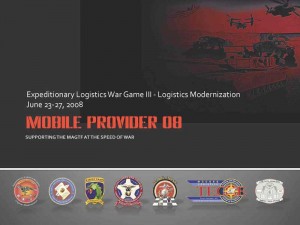
The USMC has been wargaming its approach to logistics as it seeks to improve its expeditionary capability. For the USMC, shaping an effective approach to expeditionary logistics is seen as central to core capabilities. During one such exercise, Mobile Provider 08, which was held at Camp Johnson, near Camp Lejeune in North Carolina, the USMC shared its findings with regard to the ongoing challenges and approaches to shaping expeditionary logistics. The game will become an annual event to test conceptual development against operational experience to the benefit of both. Indeed, the USMC is completing the 2009 game in September and SLDinfo.com will report on the results of this game when those results become available. As one participant characterized the wargamet: “It is historic to have this level of participation from core elements of the logistics command element of the Marine Corps Air-Ground Task Force (MAGTF).”
MP 08 was a five-day, operational-level, two-sided wargame that involved simulation and the use of LogMod bridging technologies (discussed in the companion piece on LogMod) for command and control (C2) and execution of Logistics Chain Management (LCM) functions. In the words of the organizers, “MP 08 is to examine innovative operational, and technological approaches to expeditionary logistics support to a Marine Air-Ground Task Force (MAGTF) in maneuver, with particular emphasis on the role and impact of field-level supply, maintenance, and distribution.” According to one of the organizers of the event, “The aviation command element has their core level planning event; the ground combat element has its core level training exercise; this war game is equivalent for the logistics command element of the MAGTF.”
Representatives from the first, second and third Marine Expeditionary Force (MEFs), the logistics integration division, USMC systems command, USMC logistics command, USMC special operations command as well as from USMC aviation and ground elements were involved in the war game.
The more than 90 participants were broken down into four cells representing units and/or staffs within:
- MEF Command Element, Marine Air Wing (MAW) and Supporting Establishment;
- Marine Logistics Group (MLG) and General Support Combat Logistics Regiment (GS CLR);
- Direct Support (DS) CLR and Regimental Combat Team (RCT) as the primary maneuver unit within the Ground Combat Element (GCE); and
- DS Combat Logistics Battalion (CLB).
The setting was also significant. Last year’s event was staged at Quantico. The gamet was played in the new USMC Tactical Decision Center (TDC). The TDC was established in the summer of 2007 in order to train students and operating force Marines in a wide spectrum of simulated command post exercises. The TDC orientation book identifies the focus of the TDC as follows:
Development of the TDC was based upon a concept that leverages recently demonstrated successes of the Logistics Common Operating Picture (LCOP) process in OIF, as well as, the core requirements for establishing a CLOC in any LCE organization. The TDC operates using currently recognized “bridge systems”, as specified by MARADMIN 444/05, until GCSS-MC is fielded. These systems include Battle Command Sustainment Support System (BCS3), Command and Control Personal Computer (C2PC), Warehouse to Warfighter (W2W), Transportation Capacity Planning Tool (TCPT), Force XXI Battle Command Brigade and Below/Blue Force Tracker (FBCB2/BFT), and Common Logistics Command and Control System (CLC2S). Additionally, students will have access to other current systems and databases, such as the, Asset Tracking for Logistics and Supply System (ATLASS), Marine Equipment Readiness Information Tool (MERIT), and Logistics Automated Information System 7.1 (LOG AIS 7.1). The TDC will also allow students to execute RFID procedures as performed in the Combat Logistics Area (CLA) and will utilize a convoy operations simulation system to allow students to simulate convoy operations simultaneously with CLOC operations. The TDC is also capable of functioning as a higher headquarters CLOC in support of Field Training Exercises (FTX), such as the Logistics Officer (LOC) FEX. All of these operations, performed together, will provide students with a realistic and challenging environment for learning.
The game had five major objectives:
- C2 relationships and actions required to conduct expeditionary logistics operations, specifically exploring the interaction between C2 and logistics chain management (LCM);
- Determine MAGTF in the maneuver impact on ground supply chain and maintenance operations;
- Affirm alignment of field maintenance capability functions among organic units in the maneuver;
- Evaluate expeditionary LCM concepts, specifically, to delineate field-level logistics roles, responsibilities, and capabilities;
- Exercise responsiveness of MAGTF distribution in the maneuver.
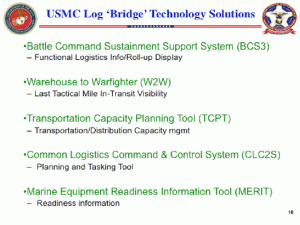
The exercise relied on using several of the USMC bridging technologies being introduced prior to full-scale introduction of the fully modernized approach. The major bridging technologies are the Battle Command Sustainment and Support System, the Transportation Capability Planning Tool and the Common Logistics Command and Control System. These tools were used to try to more effectively connect the expeditionary forces with their supply and logistics systems.
The USMC is focusing in the modernization effort, not on a land operation like Iraq, but on expeditionary operations. As one Marine put it, “You can build a Wall Mart in Iraq to supply troops. In the field, you live or die by timely supply with no Wall Mart Credit Card in hand to solve the problem.”
At the center of the conceptual rethink is developing pull logistics, rather than just-in-time logistics. The Marines simply do not believe that just-in-time logistics works, and push logistics is simply inefficient. The forces need to pre-position support packages which can be used by the deploying forces. The goal is to shape predictive support packages for the most likely maintenance events. Obviously, there can never be 100% predictive behavior but the goal is to determine what can be predicted so that supply lines and communication capabilities are more effectively utilized.
The game drew upon three key supporting concepts. The first was inventory positioning. “Inventory Positioning (IP) is focused on positioning maintenance support capabilities based on readiness based sparing and virtual kitting at critical nodes on the battlefield.” The second was the use of Tactical Maintenance Time Windows (TMTW). “TMTW identifies the tactical maintenance time (TMT) available under expeditionary maneuver conditions at the supported unit….” The final element was Maintenance Event Management (MEM). “MEM is the process of managing deadlining maintenance event frequency. Maintenance event code is identified for a repair action, e.g., brake repair. The (event) is associated to: a bill of materials for parts, i.e. VK; tools needed for the repair; level of maintenance expertise; number of mechanics needed; echelon of repair/level of maintenance; level of repair facility/ evacuation criteria and; number of hours needed to complete the repair. Tracking maintenance event failure rates by frequency and battlefield occurrence will provide more efficient maintenance capability planning and IP.
By enhancing pre-supply of predictive elements, the forces can maximize their ability to use communications and command elements to focus on supplying critical supplies. The USMC is keenly aware of the limits on bandwidth available to the expeditionary warrior and seeks to craft an approach, which is realistic in terms of bandwidth and effective in reach to the expeditionary forces.
The goal of this effort is to focus on shaping capability, not moving bits around the table of a logistics board. As the USCM analysts put it: “In terms of maintenance, the only parts or group of parts that matter to the MAGTF Commander are the ones that provide him a capability.”
The USMC conceptual approach refers to the predictive events as “virtual kitting.” And the task is then to management the “virtual kits” to improve pull logistics and an ability to pre-supply for the most frequently recurring events. The objective is to push capabilities, not parts. And the challenge is to overcome the classic approach to logistics, which is a pull approach with its inherent limitations and dysfuntionalities.
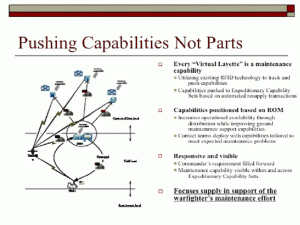
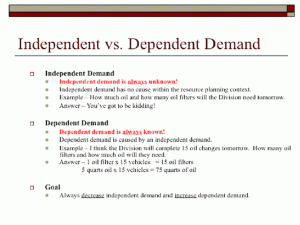
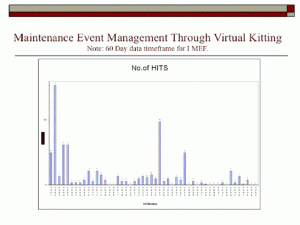
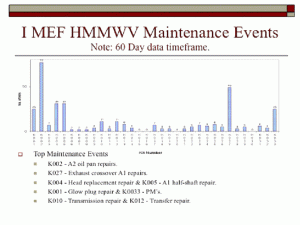
Instead of simply having depot based supplies or believing in the mythology of just- in-time logistics, the USMC is seeking to develop a middle way. By basing their efforts on assessments of past logistics behavior and by building models of that behavior, planning can focus on putting replacement assets forward to the extent predictable from past behavior. The other advantage of this approach according the Marines is that you have greater slack in the system to deal with unpredictable events, many of which could prove critical to success of deploying expeditionary forces. The goal is to enhance the capacity to surge to unexpected events whilst maximizing predictable support events. Events are defined simply as frequently occurring situations which are defined in terms of packages of parts and equipment, rather simply single piece inventory assessments. The more success you have with this system, the more one can identify anomalies and determine to what extent these are predicable as well.
The basic approach rests on crafting a “Virtual Kitting” approach which is defined as:
- A group of National Stock Numbered (NSN)’s (parts) associated to a particular Preventive Maintenance (PM) or Corrective Maintenance (CM) event;
- NSN’s are managed and delivered collectively as a “kit” but are not boxed together;
- The “virtual kit” stockage level is forecasted however the stockage levels for the associated NSN’s are calculated as dependent demands.
The USMC analysts then describe the resulting management task for “virtual kitting” as follows:
- “Viirtual Kits” will be loaded to the Supported Activities Supply System Management Unit (SMU) General Account General Account Balance File (GABF);
- “Virtual kits” will be locally assigned and tracked via requirement code on the GABF;
- The NSNs associated with each kit will be compared to current asset posture daily to ensure that every NSN for every kit is available for immediate issue.
The goal of the “virtual kitting” effort is to decrease independent demand and to increase dependent demand.
An example cited in briefings during the wargame was that of providing for supplies for a HUMVEE. By tracking a 60 day cycle of maintenance, the most likely events were identified needs support. Then the repair tasks could be conceptualized as maintenance events, and parts clustered and pushed forward to support the predictable problems likely to happen tasking the supply chain.
During the game three key themes were especially predominant. These themes, in turn, will provide important inputs into the further evolution of the USMC LogMod effort.
The first key theme was on the C2 dimension. The effectiveness of an integrated logistics chain in the maneuver was viewed as highly dependent upon practice C2. “The war game emphasized that an integrated logistics chain provided the ability for the CLB to have visibility into the readiness posture of the RCT allowed for validation of CSS requests from the supported unit and enhanced push logistics when applicable. ”
The second theme or conclusion which emerged was that maintenance-event based planning enables more effective logistics execution. “Inventory positioning was identified as contributing to reduce repair cycle times; however, the concept requires validation. A recommendation was made to conduct a modeling and simulation study to validate the concept and accurately assess its potential for future implementation.”
The third key thematic was the role of distribution as the lynchpin of the integration of supply and maintenance. “Distribution was the most often discussed issue during MP 08 as it was identified as a critical enabler of ground supply chain and maintenance operations for a MAGTF in the maneuver. The war game validated the placement, roles and responsibilities of distribution elements outlined in MDDP, particularly the placement of the DLC’s within the CLB. Additionally, the war game evaluated the use of RFID at maintenance collection points and for reverse logistics support of damaged equipment and secondary reparables (SECREP). Issues regarding command relationships between movement agencies did arise during the war game, such as the relationship between the MMDC and the DLCs. It was recommended that MAGTF Distribution Doctrine be developed to support MAGTF Deployment and Distribution Policy to implement to formalize Marine Corps distribution doctrine.”
In short, the organizers of the event were very pleased with the level and quality of participation in the war game. Indeed, discussions with participants indicated significant buy-in to the new approach but continued concerns with effectively implementing “push” logistics. While no one doubted the advantage of the approach, there was much discussion of how extensively this could be done and how effectively. According to one of the organizers, it is hoped that they can bring the advanced logistics operational course graduates into future games. This would allow for a better dialogue between planners and executors.
An earlier version of this article appeared in Military Logistics International in the summer of 2008.
———-
***Posted September 6th, 2009

